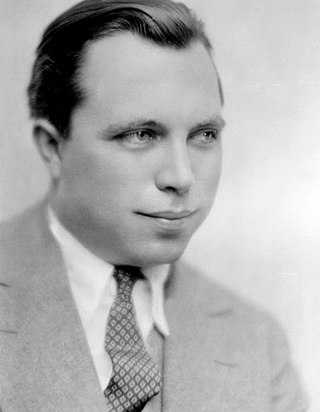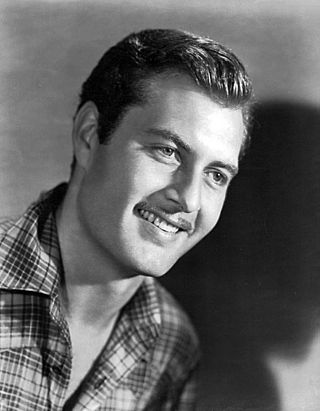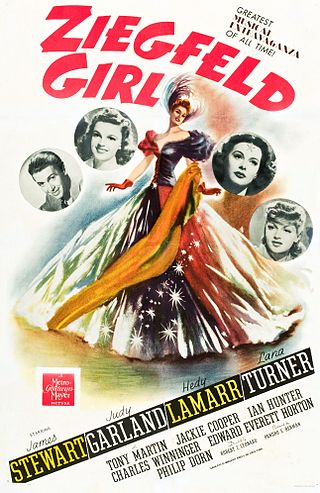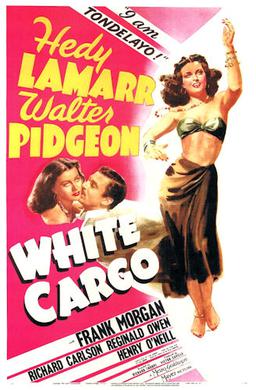
Ava Lavinia Gardner was an American actress. She first signed a contract with Metro-Goldwyn-Mayer in 1941 and appeared mainly in small roles until she drew critics' attention in 1946 with her performance in Robert Siodmak's film noir The Killers. She was nominated for an Academy Award for Best Actress for her performance in John Ford's Mogambo (1953), and for best actress for both a Golden Globe Award and BAFTA Award for her performance in John Huston's The Night of the Iguana (1964). She was a part of the Golden Age of Hollywood.

King Wallis Vidor was an American film director, film producer, and screenwriter whose 67-year film-making career successfully spanned the silent and sound eras. His works are distinguished by a vivid, humane, and sympathetic depiction of contemporary social issues. Considered an auteur director, Vidor approached multiple genres and allowed the subject matter to determine the style, often pressing the limits of film-making conventions.

Hedy Lamarr was an Austrian-born American actress and inventor. After a brief early film career in Czechoslovakia, including the controversial erotic romantic drama Ecstasy (1933), she fled from her first husband, Friedrich Mandl, and secretly moved to Paris. Traveling to London, she met Louis B. Mayer, who offered her a film contract in Hollywood. Lamarr became a film star with her performance in the romantic drama Algiers (1938). She achieved further success with the Western Boom Town (1940) and the drama White Cargo (1942). Lamarr's most successful film was the religious epic Samson and Delilah (1949). She also acted on television before the release of her final film in 1958. She was honored with a star on the Hollywood Walk of Fame in 1960.

Robert George Young was an American film, television, and radio actor best known for his leading roles as Jim Anderson, the father character, in Father Knows Best and the physician Marcus Welby in Marcus Welby, M.D. (ABC). In 1978, Young produced a documentary that "stressed the importance of motorcycle training for teenagers." This film earned him the 1979 BAFTA Award for Best Specialised Film.

Samson and Delilah is a 1949 American epic romantic biblical drama film produced and directed by Cecil B. DeMille and released by Paramount Pictures. It depicts the biblical story of Samson, a strongman whose secret lies in his uncut hair, and his love for Delilah, the woman who seduces him, discovers his secret, and then betrays him to the Philistines. It stars Victor Mature and Hedy Lamarr in the title roles, George Sanders as the Saran, Angela Lansbury as Semadar, and Henry Wilcoxon as Prince Ahtur.

Ecstasy is a 1933 Czech erotic romantic drama film directed by Gustav Machatý and starring Hedy Lamarr, Aribert Mog, and Zvonimir Rogoz. Machatý won the award for Best Director for this film at the 1934 Venice Film Festival.

Ruth Carol Hussey was an American actress best known for her Academy Award-nominated role as photographer Elizabeth Imbrie in The Philadelphia Story.

George Montgomery was an American actor, best known for his work in Western films and television. He was also a painter, director, producer, writer, sculptor, furniture craftsman, and stuntman. He was engaged to Hedy Lamarr in 1941, and married Dinah Shore in 1943.

Zenobia is a 1939 comedy film directed by Gordon Douglas and starring Oliver Hardy, Harry Langdon, Billie Burke, Alice Brady, James Ellison, Jean Parker, June Lang, Stepin Fetchit and Hattie McDaniel. The source of the film was the 1891 short story "Zenobia's Infidelity" by H.C. Bunner, which was originally purchased by producer Hal Roach as a vehicle for Roland Young.

Comrade X is a 1940 American comedy spy film directed by King Vidor and starring Clark Gable and Hedy Lamarr. The supporting cast features Oskar Homolka, Felix Bressart, Sig Rumann and Eve Arden. In February 2020, the film was shown at the 70th Berlin International Film Festival, as part of a retrospective dedicated to King Vidor's career.

John Loder was established as a British film actor in Germany and Britain before migrating to the United States in 1928 for work in the new talkies. He worked in Hollywood for two periods, becoming an American citizen in 1947. After living also in Argentina, he became a naturalized Argentinian citizen in 1959.

Ziegfeld Girl is a 1941 American musical film directed by Robert Z. Leonard and starring James Stewart, Judy Garland, Hedy Lamarr, Lana Turner, Tony Martin, Jackie Cooper, Eve Arden, and Philip Dorn. The film, which features musical numbers by Busby Berkeley, was produced by Metro-Goldwyn-Mayer.

White Cargo is a 1942 American drama film starring Hedy Lamarr and Walter Pidgeon, and directed by Richard Thorpe. Released by Metro-Goldwyn-Mayer, it is based on the 1923 London and Broadway hit play by Leon Gordon, which was in turn adapted from the 1912 novel Hell's Playground by Ida Vera Simonton. The play had already been made into a British part-talkie, also titled White Cargo, with Maurice Evans in 1930. The 1942 film, unlike the play, begins in what was then the present-day, before unfolding in flashback.

I Take This Woman is a 1940 American drama film directed by W. S. Van Dyke and starring Spencer Tracy and Hedy Lamarr. Based on the short story "A New York Cinderella" by Charles MacArthur, the film is about a young woman who attempted suicide in reaction to a failed love affair. The doctor who marries her attempts to get her to love him by abandoning his clinic services to the poor to become a physician to the rich so he can pay for her expensive lifestyle.

Kid Glove Killer is a 1942 American crime film, starring Van Heflin as a forensic scientist investigating the murder of a mayor. The B film, the feature-length directorial debut of Fred Zinnemann, was an expanded version of the 1938 Crime Does Not Pay short subject "They're Always Caught".

Come Live with Me is a 1941 American romantic comedy film produced and directed by Clarence Brown and starring James Stewart, Hedy Lamarr and Ian Hunter. Based on a story by Virginia Van Upp, the film is about a beautiful Viennese refugee seeking United States citizenship who arranges a marriage of convenience with a struggling writer.

The Strange Woman is a 1946 American historical melodrama film directed by Edgar G. Ulmer and starring Hedy Lamarr, George Sanders and Louis Hayward. It is based on the 1941 novel of the same title by Ben Ames Williams. The screenplay was written by Ulmer and Hunt Stromberg. Originally released by United Artists, the film is now in the public domain.

Let's Live a Little is a 1948 American romantic comedy film directed by Richard Wallace and starring Hedy Lamarr, Robert Cummings and Anna Sten. Written by Howard Irving Young, Edmund L. Hartmann, Albert J. Cohen, and Jack Harvey, the film is about an overworked advertising executive who is being pursued romantically by his former fiancée, a successful perfume magnate, who is also the ad agency's largest client. While visiting a new client—a psychiatrist and author—to discuss a proposed ad campaign, his life becomes further complicated when the new client turns out to be a beautiful woman, who decides to treat his nervous condition.

The Female Animal is a 1958 American CinemaScope drama film directed by Harry Keller and starring Hedy Lamarr, Jane Powell, Jan Sterling and George Nader.
Elizabeth Hill was an American screenwriter and the third wife of King Vidor.




















